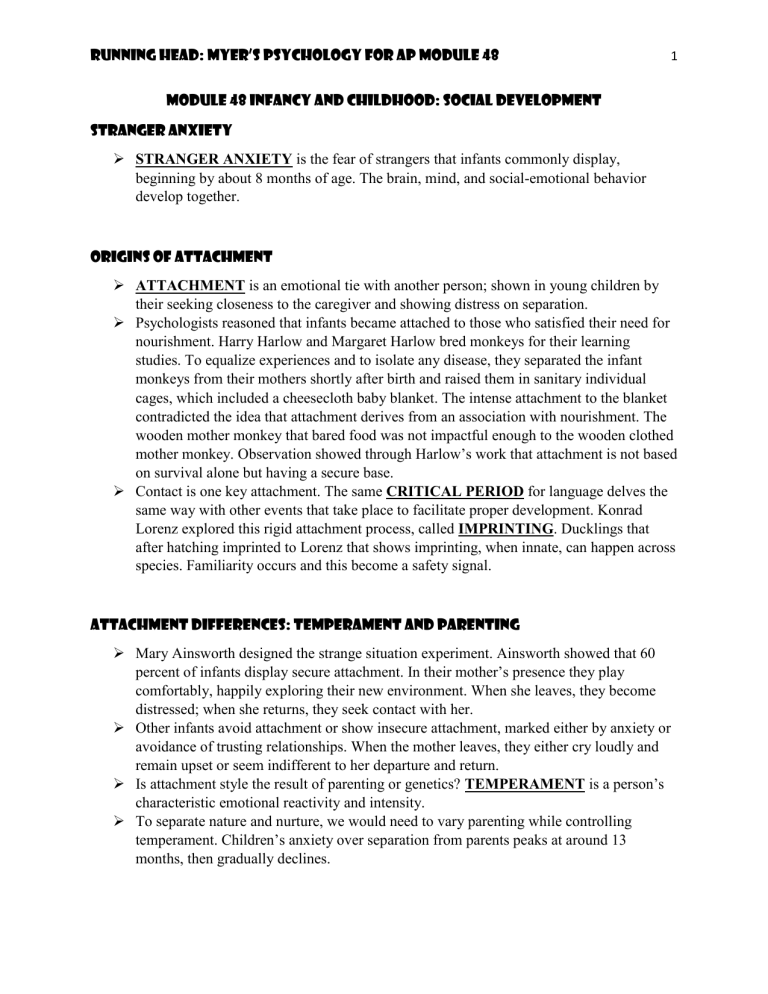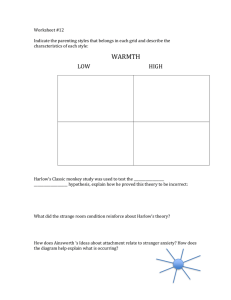
Running head: myer’s psychology for ap module 48 1 Module 48 infancy and childhood: social development Stranger anxiety STRANGER ANXIETY is the fear of strangers that infants commonly display, beginning by about 8 months of age. The brain, mind, and social-emotional behavior develop together. Origins of attachment ATTACHMENT is an emotional tie with another person; shown in young children by their seeking closeness to the caregiver and showing distress on separation. Psychologists reasoned that infants became attached to those who satisfied their need for nourishment. Harry Harlow and Margaret Harlow bred monkeys for their learning studies. To equalize experiences and to isolate any disease, they separated the infant monkeys from their mothers shortly after birth and raised them in sanitary individual cages, which included a cheesecloth baby blanket. The intense attachment to the blanket contradicted the idea that attachment derives from an association with nourishment. The wooden mother monkey that bared food was not impactful enough to the wooden clothed mother monkey. Observation showed through Harlow’s work that attachment is not based on survival alone but having a secure base. Contact is one key attachment. The same CRITICAL PERIOD for language delves the same way with other events that take place to facilitate proper development. Konrad Lorenz explored this rigid attachment process, called IMPRINTING. Ducklings that after hatching imprinted to Lorenz that shows imprinting, when innate, can happen across species. Familiarity occurs and this become a safety signal. Attachment differences: temperament and parenting Mary Ainsworth designed the strange situation experiment. Ainsworth showed that 60 percent of infants display secure attachment. In their mother’s presence they play comfortably, happily exploring their new environment. When she leaves, they become distressed; when she returns, they seek contact with her. Other infants avoid attachment or show insecure attachment, marked either by anxiety or avoidance of trusting relationships. When the mother leaves, they either cry loudly and remain upset or seem indifferent to her departure and return. Is attachment style the result of parenting or genetics? TEMPERAMENT is a person’s characteristic emotional reactivity and intensity. To separate nature and nurture, we would need to vary parenting while controlling temperament. Children’s anxiety over separation from parents peaks at around 13 months, then gradually declines. Myer’s psychology for ap module 48 2 Erik Erikson and Joan Erikson believed that securely attached children approach life with a sense of BASIC TRUST is a sense that the world is predictable and reliable. Our early attachments form the foundation for our adult relationships and our comfort with affection and intimacy. Attachment style is also associated with motivation. Deprivation of attachment Most children growing up under adversity (foster care systems or neglect or abuse) are resilient; they withstand the trauma and become normal adults. Idea of “abuse-breedabuse” phenomenon. Most abusive parents and many condemned murderers have reported being neglected or battered as children. Abused children exhibit hypersensitivity to angry faces. Most show brain changes with the chemical serotonin, which calms aggressive impulses. Behavior and emotion arise from a particular environment interacting with particular genes. Relationships that end suddenly take a toll on adult attachments to come. Detaching is a process, not an event. Day care Does day care impact child’s development? No. Children are biologically sturdy individuals who can thrive in a wide variety of life situations. There is no major impact of maternal employment on children’s development, attachments, and achievements. Children who spent time in day care had slightly advanced thinking and language skills. They also had an increased rate of aggressiveness and defiance. To developmental psychologist Eleanor Maccoby, the positive correlation between the increased rate of problem behaviors and time spent in child care suggested “some risk for some children spending extended time in some day-care settings as they’re now organized. Self-concept SELF-CONCEPT is an understanding and assessment of who they are. Self-awareness begins when we recognize ourselves in a mirror. To see whether a child recognizes that the girl in the mirror is indeed herself, researchers sneakily dabbed color on the nose. By 15 to 18 months, they begin to touch their own noses when they see the colored spot in the mirror and by 18 months have a schema of how their face should look, and they wonder, “What is that spot doing on my face?” Children’s views of themselves affect their actions. Myer’s psychology for ap module 48 3 Parenting styles There are three parenting styles: 1. Authoritarian, 2. Permissive, and 3. Authoritative. AUTHORITARIAN are where parents impose rules and expect obedience (too hard). PERMISSIVE parents submit to their children’s desires and are their friends (too soft). AUTHORITATIVE parents are both demanding and responsive and set rules that are understanding (just right). Remember that parenting styles is a correlation but not causation. Culture and child raising Culture changes idea of self. Western culture views independence while many Asian and African lives in culture view family identity. What brings honor to the child brings honor to the family. Neither prove to be better child raising techniques than the other. Be able to answer: What distinguishes imprinting from attachment? Practice frq: Name and describe the three types of infant temperaments.
